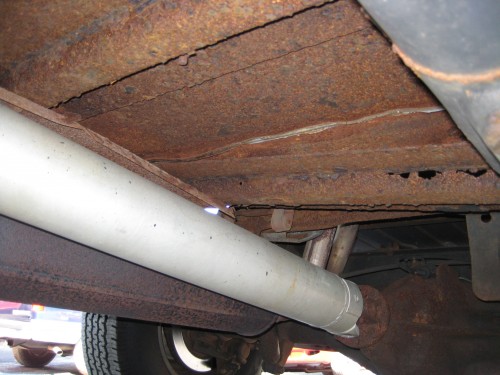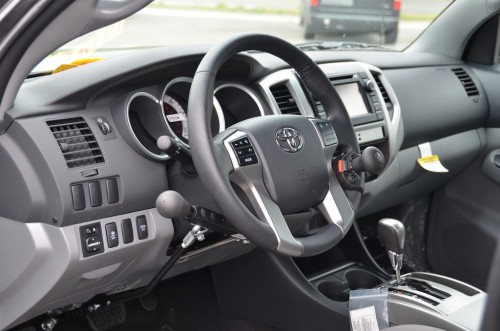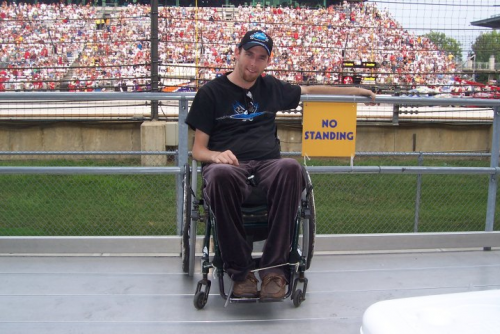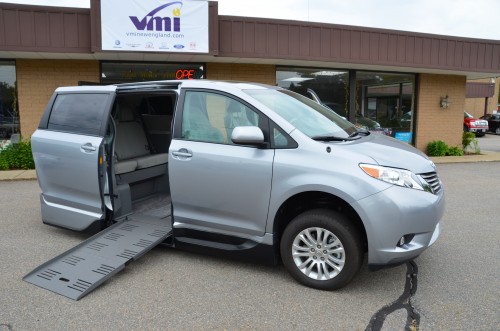| VETERANS BENEFITS | ||
| Come to VMi New England Mobility Center and learn more about the Paralyzed Veterans of America and Operation Independence | ||
 |
||
| OPERATION INDEPENDENCE VMI is the premier manufacturer of wheelchair accessible vans. At the VMi New England Mobility Center we are experts in mobility assessment and customization. We have combined our knowledge with the Veterans across America to increase awareness with disabled veterans regarding VA vehicle benefits, and help them get the benefits they have earned while serving our country: • You may be entitled to VA funding for adaptive automotive equipment • In many cases, you may also be entitled to a one-time auto allowance for the vehicle itself.Operation Independence helps veterans get into their first wheelchair accessible van. Whether you are entitled to the auto allowance grant or will be personally funding your first wheelchair accessible van, the VMi New England Mobility Center will give you a $1,000 rebate towards the van we are converting for you.VETERAN MOBILITY BENEFITS To be eligible for financial assistance in purchasing a new or used automobile (or other conveyance), a Veteran or serviceperson must have acquired one of the following disabilities as a result of injury or disease incurred or aggravated during active military service, or as a result of medical treatment or examination, vocations rehabilitation, or compensated work therapy provided by the Department of Veterans Affairs (VA) (38 U.S.C. 1151):• Loss, or permanent loss of use, of one or both feet • Loss, or permanent loss of use, of one or both hands, or • Permanent impairment of vision in both eyes with a • Central visual acuity of 20/200 or less in the better eye with corrective glasses, or • Central visual acuity of more than 20/200 if there is a field defect in which the peripheral field has contracted to such an extent that the widest diameter of visual field has an angular distance no greater than 20 degrees in the better eye Even if you are not entitled to the auto allowance grant (21-4502), you may still qualify for an adaptive automotive equipment grant (10-1394) for a wheelchair accessible conversion on a vehicle which you would fund through alternative means. . |
||
| “FEDERAL BENEFITS FOR VETERANS, DEPENDENTS AND SURVIVORS” | ||
|
||
|
VA 4502 GRANT
|
||
|
The grant is paid directly to the seller of the automobile for the total price (up to $18,900) of the automobile. The veteran or service member may only receive the automobile grant once in his/her lifetime. Section 804- Enhancement of automobile assistance allowance for veterans would increase automobile assistance from $11,000 to $18,900, effective October 1, 2011 Click here to see a pdf for more details Automobile and Special Adaptive Equipment Grants Click here to review the Federal Form VBA-21-4502 Automobile Adaptive Equipment (AAE) Veterans are trained, through the VA Driver’s Rehabilitation Program, how to safely operate their vehicle on our nation’s roadways. The VA also provides necessary equipment such as platform wheelchair lifts, UVLs (under vehicle lifts), power door openers, lowered floors/raised roofs, raised doors, hand controls, left foot gas pedals, reduced effort and zero effort steering and braking, and digital driving systems. Additionally, VA’s program provides reimbursements for standard equipment including, but not limited to, power steering, power brakes, power windows, power seats, and other special equipment necessary for the safe operation of an approved vehicle. For more information click on the link below. |
||
|
DEPARTMENT OF VETERANS AFFAIRS “Automobile and Special Adaptive Equipment Grants” Can a Veteran Receive Financial Assistance From VA to Purchase an Automobile? The grant is paid directly to the seller of the automobile for the total price (up to $11,000) of the automobile. The veteran or servicemember may only receive the automobile grant once in his/her lifetime. What Disabilities Must You Have to Qualify for the Automobile Grant? • loss, or permanent loss of use, of one or both feet Does VA Pay to Adapt a Vehicle? Adaptive equipment includes, but is not limited to, power steering, power brakes, power windows, power seats, and special equipment necessary to assist the eligible person into and out of the vehicle. Contact should be made with your local VA medical center’s Prosthetic Department prior to purchasing any equipment. The adaptive equipment grant may be paid more than once, and it may be paid to either the seller or the veteran. How Can I Apply for an Automobile and/or Special Adaptive Equipment Grant? Note: After you complete and submit Section I of the application, VA will complete Section II and return the original to you. You are responsible for obtaining the invoice from the seller, updating Section III, and submitting the form to your local VA regional office for payment. If you are entitled to adaptive equipment only (i.e., service connected for ankylosis of knees or hips) you should complete VA Form 10-1394, Application for Adaptive Equipment – Motor Vehicle and submit it to your local VA medical center. Additionally, VA Form 10-1394 should be completed for approval of equipment not specified on the VA Form 21-4502. |
Category Archives: Mobility
Putting Amputees Back in the Driver’s Seat
For most of us, an automobile is a necessity rather than a luxury.
To have a full life in America requires mobility -not just the ability to walk or run, but the ability to travel greater distances with more convenience and flexibility than public transportation provides.
For many lower-limb amputees, however, the lack of feet makes driving impossible in a conventionally equipped vehicle. Hand controls along with left foot gas pedals provide the solution. They make it possible for lower-limb amputees and people with other disabilities to enjoy the prosperity and independence that comes with vehicle ownership and use.
Different types of hand controls
Basic hand controls usually consist of a lever attached to a bracket and mounted under the steering column on cars equipped with automatic transmissions. The lever is moved to operate throttle and brakes. Usually the left hand operates the control, allowing the right hand to steer and operate the vehicle’s accessories. The three most common types of hand controls are push/rock, push/twist, right angle pull, and push/pull.
The push rock and push twist hand control works by twisting the handle to apply the gas and pushing it to apply the brakes. The right angle pull hand control works by moving the lever down towards the driver’s lap for acceleration. To apply the brakes, the driver pushes the handle forward towards the front of the car. The push/pull hand control works by pulling on the handle to apply the gas, and pushing for the brakes. Most hand controls, except for a very few, apply the brakes by pushing.
Most hand controls are hand-powered, using linkages or cables to operate the gas and brakes. Some models are power-assisted to make it easier on the hand and arm. Cars are designed for the driver’s foot to operate the gas and brake, so the force required to operate the hand control can be tiring to the hand during long drives. Power-assist options for hand controls range from very complex devices such as an electric joystick, to relatively simple ones that use vacuum power like power brakes. Most hand controls are dual-action devices that permit the simultaneous application of throttle and brake. Dual-action controls are helpful when the car is stopped on a steep hill or when making tight maneuvers on steep grades. The throttle can be applied a little before releasing the brake to prevent the car from coasting backward before moving forward. While most users prefer dual-action, some prefer single-action units because they eliminate the chance of accidentally applying the throttle during braking.
Which is best for you?
The best choice of hand controls for a person depends on a number of factors, such as the car’s layout, expected driving conditions, and the driver’s size, disability, and preference.
Push/twist
Push/twist hand controls are a good choice if either a large driver, a small car, or both, limit space. Economical use of space is achieved because the lever only needs to be moved to apply the brake. Throttle control is achieved by twisting the grip in the same manner as operating a motorcycle.
Push/twist controls provide a precise, sporty feel. By necessity, push/twist hand controls are often power-assisted. Without power-assistance, the twisting motion tends to feel stiff, and the hand tires. With a good quality power-assisted twist control, very little effort is required to maintain a throttle setting; simply resting the hand on the handle should provide enough force. This results in less fatigue on long drives.
Push/twist controls are good in tight turns and on rough roads. Throttle surges, which can be experienced with a push/pull or right angle pull device, as the driver and his or her arm bumps, sways, leans, or lurches going through curves and over bumps tend not to occur with a push/twist. Most push/twist controls are dual-action units.
These controls are not recommended for people with grip problems or those with amputated fingers or hands. Good left-hand dexterity is required for safe driving with push/ twist controls.
Right angle pull
Right angle pull controls are the most widely used form of hand control. They are relatively inexpensive and, usually, easy to install and adjust. Operation is simple and intuitive for these strictly mechanical units.
Space, however, can be a problem. Throttle application requires that the lever be moved down toward the driver’s lap. If the driver is large or the car is small, a push/twist or even a push/pull control may be more suitable. Because the lever is connected to the gas pedal with mechanical linkages, the underside of the dashboard will often require trimming.
For those missing fingers, hands, or with reduced grip strength, various handles, wrist straps, grips, etc., can be adapted for the right angle pull control. Specialized handles can be configured for use with a prosthesis. Right angle pull controls are usually dual-action, but also can be single-action.
Push/pull
Push/pull hand controls are by definition single-action. Since the lever is pulled for gas and pushed for brakes, the gas and brakes can never be operated at the same time.
This is the easiest hand control to learn to use. Senior citizens like the push/pull because there is no confusion when learning, after using the foot pedals all their lives. Power-assisted and non-power-assisted models are available. The driver’s hand can rest directly on the lever without causing the throttle to surge.
As with the right angle pull control, different handles can be adapted to the driver to permit safe and easy operation. Power-assisted push/pull hand controls equipped with handle adaptations are recommended for people with limited arm strength and poor manual dexterity.
Some other factors to consider
When shopping for hand controls, aesthetics is also a factor to consider. Car owners can be surprised to find that a section of the dashboard was cut away during the installation process. Most hand controls are mounted under the dash with a support extending into the driver space under the steering column where the lever is connected. A panel under the dashboard is removed during installation. If the hand control’s design and the dashboard layout permit, the panel can be returned allowing the mounting bracket to be hidden. Sometimes, however, the hand control’s hardware protrudes into the passenger space, and the panel cannot be reinstalled without cutting a window in it. Each installation varies with the model of automobile and the particular hand-control unit. Check with your dealer about what you can expect to see when you get your car back.
Many of us share cars with other family members. It is important that the pedals can still be used with the hand control installed and that there are as few impediments to using them as possible. Most good controls provide room for a pedal-pushing driver. Ask the installer what to expect.
Driving should be fun. Poorly designed hand controls, or a badly performed installation, can cause the driver to be distracted or preoccupied with the control, lead to frustration, and reduce safety. Good hand controls, professionally installed, will allow enjoyable, safe driving.
Installation
No matter what type of hand controls you use, you are making a significant modification to your vehicle. It is, therefore, important to have a trained and qualified person perform the installation.
The installer should cut a minimum amount of the dashboard. The handle should be located in a comfortable position so that the driver can hold on to the hand control and hook a thumb over the steering wheel. This position helps to stabilize the steering wheel and the throttle. The whole assembly should feel solid and sturdy. If the installation is done properly using a high-quality control, driving will be easy and fun.
Everyone is different, and each person is a special case. If you are uncertain about your condition and your abilities, consult a Certified Driving Rehabilitation Specialist (CDRS). A CDRS knows about different disabilities and can advise you about the best solution to your driving needs. Contact a CDRS through your rehabilitation facility or through your local amputee support group.
Whether you are a first-time buyer or already drive with hand controls, it is good to know what is out there and what to look for. High-quality hand controls are available, as are skilled mobility technicians who understand the quality and safety issues involved with their installation.
Spend a few extra dollars to purchase a high-quality product and have it professionally installed. You already have made a significant investment in your vehicle. A quality set of hand controls will surely enhance your driving experience and, above all, your safety.
How To Really Move On When You Can No Longer Walk
There are a lot of nightmare scenarios no one wants to personally experience. One is getting a phone call that someone you love is hurt and another — permanently ending up in a wheelchair. Many people say they’d rather be dead if this happened to them, but oh how things change when you actually find yourself in this situation.
Simply put people don’t want to die, so they deal with it and move on, but it’s never that easy. And for some even, they’re never able to, so forever languishing in a living hell.
To truly see how it is possible to move on after becoming a wheelchair-user and be enlightened, read on for seven awesome insights.
Accept that you must reinvent yourself.
One of the first things to know when you become a wheelchair-user is that you are no longer who you were before. If your body is different after going through such a dramatic injury. A lot of people fight against this, wanting to hold onto their previous able-bodied self, but the fact is they will never be that person again.
Instead of desperately holding onto someone you once were, embrace this as an opportunity to reinvent yourself. If you no longer do tree work, get that engineering degree you always wanted and finally feed that part of your brain from here on out. A serious bodily injury can really open new doors.
Find out how to still use your body as much as possible.
It can be so difficult no longer being able to use your body like before, but don’t give up on moving your body just because you can’t use it 100 percent. Instead, push yourself as much as possible. If you can’t move your legs, you can try electrical stimulation to the legs. If you can’t transfer yourself but you get really close, try for years until you finally get it. Never give up on your body’s strength and pushing it (safely of course). Even if you move your body involuntarily, knowing you’re still utilizing all four limbs in some way is a must for the soul long-term.
You should also be working out on a regular basis. Serious cardio and strength training is a must when you use a wheelchair since getting your heart rate can be a great way to boost endorphins in the brain. When you’re not getting the cardio you would otherwise get from regular able-bodied activities, like walking all the time, you must find another way to get it. It’s a huge must.
Develop a negative thinking coping mechanism.
It can be almost too easy getting into a negative train of thought when things aren’t going well as a wheelchair-user. The tendency to blame the wheelchair for all of your problems is almost too easy. Whenever you find yourself angry because you need a wheelchair, try to click your mind into a positive place; a place you’ve created just for this. Maybe it’s a happy memory or a place you absolutely love.
Take on the “survivor success” mentality.
I love this one. Never forget that you are a survivor for living life sitting-down. This is an existence that challenges a human both mentally and physically. Whenever you feel empty inside because you can’t use your god-given legs, remind yourself that you are a survivor in the exact sense, and let that feed your ego if you must. Not many people can do what you do and do it so well. Yes, you do rock.
Learn to love yourself.
It can be easy being jealous of everyone that can walk when you can’t, but if you learn to love yourself completely, you’ll be a lot happier.
If you have a hard time finding things you absolutely love about yourself, make a list and ask friends and family their input. You’ll be surprised at what you hear and chances are it will make you feel awesome.
Appreciate your unique perspective.
It can take several years to get to the mindset of enjoying the interesting perspective of living life sitting down — the people we meet, the lessons we’ve learned through our struggles, the way it helps us look at life differently, perhaps even better. When you have a body that doesn’t respond like it once did, you have no choice but to look at the world differently. This without question, sharpens the mind.
Be grateful for what you still have.
Each moment you’re able to breathe is a gift whether you believe it or not, and when you use a wheelchair this is even more true since so many of us have had near death experiences. It may sound cliche, but yes, do count your blessings.
Life is too short to wish for unicorns and golden tickets in chocolate bars. The here and the now is all we got. Enjoy your ice cream before it melts.
How have you been able to move on after becoming a wheelchair-user?
wheelchair van straight talk – preventative maintenance
Wheelchair Van Repair Maintenance and Body Work

Adaptive Equipment Installation, Repairs and Maintenance Inspections
- Check overall operating condition (abnormal noises, binding, grinding)
- Clean and lube ramp hinges
- Check tightness of ramp motor bolts /hinge bolts / rivets
- Lubricate ramp pivot pin and bushings
- Inspect and lubricate ramp drive arm
- Operate ramp to ensure proper stow deploy switch adjustment
- Verify manual operation of ramp
- Clean door track & floor
- Ensure drain holes are free of debris (lubricate all door hinges and locks)
- Check door alignment and insure correct operation
- Check sliding door harness for damage and proper operation
- Inspect door operation cables
- Inspect door full open switch
- Test battery
- Check kneel system operation, lubricate kneel chain & rollers
- Verify operation of conversion with all switches and remotes
- Check and adjust air tire pressure as posted on “b” pillar
- Vacuum floor / clean ramp
- Inspect and test transfer or jump-seat operation
- Check all wiring for proper routing and condition
- All interior and external lighting (including third brake light)
Scheduled Maintenance for Accessible Vans—Preventive maintenance plays a crucial part in the continued trouble-free operation of your adaptive equipment. All maintenance checks and repairs need to be pre-scheduled in advance. A scheduled check-up should be completed every six months. Most appointments are scheduled Monday through Friday during normal business hours. Please call us at 508-697-6006 to schedule your next service appointment.
While You Wait—Our entire staff wants you to feel at ease while we complete the maintenance and servicing of your vehicle. We provide comfortable reception areas with coffee and cable TV while you wait. For installations or repairs that may take longer then usual, we can have someone take you to a local restaurant or other destination until your automobile or van is ready.
Commercial Customers —VMi New England also provides maintenance, body work, automotive painting and repair services to commercial customers with ambulettes, paratransit buses, transport vans, and other wheelchair accessible vehicles equipped with Braun, Ricon, VMI and Maxon wheelchair lifts.
wheelchair van longevity vmi new england preventative maintenance program
Most every wheelchair van looks great on the showroom floor – when it’s shiny and new.
But, how will it hold up and perform after it’s out of the showroom?
Over the past 27+ years we’ve put together a very comprehensive preventative maintenance program to address most if not all the things that can affect a wheelchair van’s reliability, durability, safety, and performance. Our goal is to make sure that you get the most you can out of your wheelchair accessible vehicle so that it will satisfy your needs for years to come.
The preventative maintenance program covers braking systems, exhaust systems, fuel systems, sliding door systems, suspension systems, electrical systems, and most important vehicle underbody.

Heres a van that rusted out due to no maintenance years before it should had
Most of the preventative maintenance program deals with the parts and pieces of a handicapped van that you’ll never see on the showroom floor. For more than 27 years we have been putting wheelchair vans up on hoists, removing body panels & interior panels, and our engineers have taking a hard look at what makes these handicap vans last. How were they put together? How were the wires, brake lines, and fuel lines routed and connected? How well was the fuel tank protected in the event of a collision? These are all important areas of our preventative maintenance program that you don’t want to wait until your handicap vehicle is broken down along side of a road in the middle of nowhere to take a look at.
Our engineers found some very interesting things that you should know about today, well before your van is rusting out or broken down on the side of the road. These are things that certainly help keep you safe and on the road, but when not addressed will cost you a lot of time and trouble years after your purchase, not to mention that they might also affect the vehicle performance and safety. Come to VMi New England and find out more!
We will take care of you and your van even if you bought it from someone else yesterday.
BraunAbility, Vantage Mobility, Eldorado, Amerivan, IMS, Tuscany
Our program can even help if you purchase a grey market converted van online.
Our preventative maintenance program can even help if you have a FMI Freedom Motors, AMS or Rollex wheelchair van.
As you learn more about mobility vans, we hope that you’ll also see that one company, Vmi New England, does it right — from top to bottom, front to back, even though maintenance does add cost to the vehicle. We think that our customers financial resources are well spent to ensure there van is going to last! Almost everyone has financial limitations and while most of us struggle to afford a vehicle alongside all of our other household expenses, you do want your new van to last more than 3 years before rusting and falling apart! At the New England Mobility Center, driven by Jim Sanders’s passion to always offer the best, longest-lasting handicapped vehicles for our customers, just doesn’t cut corners.
We invite you to come down and take a first hand look at how and why our passion sets us above any used car dealer or chain store version of a wheelchair van dealer. Come see a complete line of side-entry and rear-entry vans for the handicapped, please visit our website: newenglandwheelchairvan.com.




